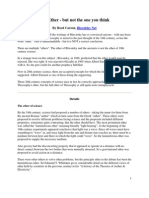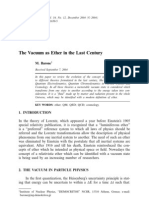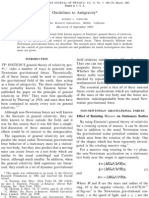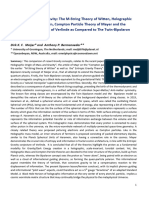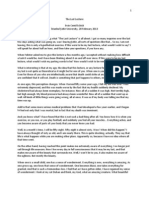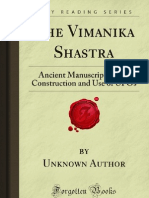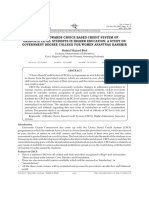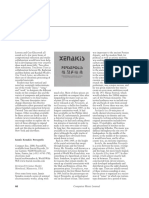Einstein and The Ether (Ludvik Kostro)
Einstein and The Ether (Ludvik Kostro)
Uploaded by
evan6402Copyright:
Available Formats
Einstein and The Ether (Ludvik Kostro)
Einstein and The Ether (Ludvik Kostro)
Uploaded by
evan6402Original Title
Copyright
Available Formats
Share this document
Did you find this document useful?
Is this content inappropriate?
Copyright:
Available Formats
Einstein and The Ether (Ludvik Kostro)
Einstein and The Ether (Ludvik Kostro)
Uploaded by
evan6402Copyright:
Available Formats
....'.
-:;\
~,~
Einstein and the ether
.t--.
~"'.'~
.14 .~
r. 0
0
...
0 .
~o"
~
Relativistic theory does not reject the existence ofan ether•
Dr Kostro, ofthe Institute ofExperimental Physics,
Gdansk University, has undertaken extensive research into
- ......
0
~ .. fIt(. • '.
t·.J!.'~· , ~jt.t. Einstein's views; that his model ofspace-time is a model ofa new ether.
~-ll~Q
....~\..- LUDVIK KOSTRO
~.
--',-
ewPoints are often expressed in Elec- Euclidean. 7,8,9) the term 'physical space' played the
\l: tronics and Wireless World which
assume that Einstein's theory and the
existence of an ether are conflicting and
The second is that of the general relativity
theory. In its mathematical description the
ten components of the g....y tensor are no
principal part in Einstein's papers. He wrote:
·Space, brought to III/ht by the corporeal
object, made a physical reality by Newton,
incompatible. It is time, therefore, that longer constant. The states described by the has In the last few decades swallowed the
some of the truths of historical record, tensor can change not only from one place to ether and time and seems to swallow al.o
concerning Einstein's views on the ether, the other, but also in time. This ether is no 8e/d and corpuscles, so that It remain. as
were given a hearing. longer rigid and flat. Its metric is pseudo- the sole carrierofreality'''.
Riemannian. In the third period 1936-1955 (see e.g. ref
'ETHER'TERMINOLOGY The third ether is that of the unitary 10) the term 'total field' or 'entire field' was
relativistic field theory. In the mathematical the term preferred by Einstein. Mer 1925
This is a distortion of the truth. Einstein did description of this ether the symmetrical Einstein began to use the word 'ether' less
deny the existence of the fixed and immobile tensor gJA,Y (where gJA,Y== &a,y) no longer de- and less often, although he still wrote in
ether of the nineteenth century, but he, scribes the ether completely, because the 1938:
nevertheless, in 1916, proposed a completely geometrical structure of it is more than
new conception of the ether. In a sense, one 6This word etlJer has dJanged its meaning
Riemannian. New structural elements have many times in the deve/opmelJt ofscience•••
can say that he was provoked into doing this to be introduced for a complete description
by the influence of H.A. Lorentz and P. Its story, by no means fInished, is con-
of the ether because it has to determine not tinuedby relativity theory"'.
Lenard. only the inertio-gravitational phenomeno-
Lorentz wrote a letter to Einstein in which na, but also electromagnetic actions. and although, in 1954, he still indicated
he maintained that the general theory of Thus, since 1916, Einstein's physics of that:
relativity admits of a stationary ether space, albeit incorporating time within the 'rigId four-dimensional space ofthe speelal
hypothesis. In reply, Einstein introduced his space dimension, became the physics of a theory of relativity Is to some extent a
new non-stationary ether hypothesis. He new ether, a physical ether and not just a four-dimensional analogue of R.A.
wrote to Lorentz on the 17th June 1916: mathematical formulation. In this physics Lorent.'s rigid three-dimensionalether"'.
I agree with you that the general relativity the three physical notions: 'space', 'ether'
and 'field' have found their complete unifica- Yet, underlying all this was his statement
theory Is nearer to an etherhypothesis than dating from 1920, made in the light of his
is the special relativity theory. However, tion through consequent identification.
early work on both the Special and General
this new ether theory would not violate the -Physical space and the ether are only Theories of Relativity that:
principle of relativity, because its state gp." different terms for the same things; fIelds
== aetherwouldnot be that ofa rigid body in -There Is an InJportant argument In favour
arephysicalstates ofspace 14. of the hypothesis of the ether. To deny the
an independent state ofmotlon, butits state
of motion would be a function of position Einstein's conception of the ether consti- existence of the ether means, In the last
determined via the materialprocesses I. tutes a gradual conceptual activation, dyna- analysis, denllng all physical propertle. to
mization and materialization of the physical emptyspace' •
Physical space (connected closely with space. According to the new conception, in According to Einstein's new conception, it
time) whose state, in relativity theory, is its most developed form, the physical space was impossible to formUlate a complete
described by the fundamental metrical ten- closely connected with time is not a passive physical theory without an (at least latent)
sor g....Y is regarded by Einstein as the and static container of events, nor is it a ether hypothesis, because every complete
relativistic ether. Einstein did not publish physically-indifferent or neutral arena of physical theory must take into consideration
his new ideas on this in 1916 or 1917 as he physical phenomena. It is an active dynamic the real properties of the physical space i.e.
advanced his work on the general theory. field medium which determines the inertio- the 'Milieu-Einflusse6'. One might not use
The first appearance of the new conception gravitational, electromagnetic and other the word 'ether' but one has still to recognize
in print was provoked by Lenard. In 1918 processes, which include the production of that physical space has real properties which
Lenard published a paper opposing Ein- elementary particles. The real physical play an active part in physical happenings
stein's relativity theory2 in which he main- space, as an active field medium of this kind, and, therefore, Einstein maintains:
tained that in the general theory the disqual- possesses energy and therefore mass as well
ified ether came back under the new name and that is why it is itself of a material
-The ether hypothesis was bound alway. to
'space'. In reply Einstein wrote an essay3 in nature. It constitutes active matter sui play a part even ifIt is IDostlya latent one at
which he published the above-presented new generis for which the term 'ether' is the most OrBtIn the thinking ofphysicists ,s.
definition of the ether. Indeed, in the period appropriate name. 1'I-IE I>I-IYSICAL E1'1-II~R
1918-1955 Einstein published about 15 pap- It must be mentioned, however, that the
ers in which he interpreted his models of three synonyms: 'physical space', 'ether' and In Einstein's special relativity ether model
space-time as models ofa new ether. 'total field' were used by Einstein with the physical space accomplishes its active
In these papers we can discriminate three different frequency in different periods: function by 'determining the inertial be..
models ofthe relativistic ether: In the period 1916-1925 (see e.g. refs 5,6) haviour of a test body introduced into it t12
The first is that of the special relativity the term 'ether' was used very often. He and possesses 'the physical property oftrans-
theory. In the mathematical description of maintained even that 'in a consequent field mitting electromagnetic waves,J1, but 'it no
this ether the ten components of the gJA,Y theory all objects of physics must be longer stands as a medium built of
tensor are constant. The related ether is embraced in the notion ofether,6. 'particles,ll or 'points" and is no longer
rigid, flat and infinite. Its metric is pseudo- In the period 1926-1935 (see e..g. refs. regarded as an immobile or stationary
238 ELECTRONICS a WlllELESS WORLD
medium. The concept of motion cannot be vinced that he had 'found the most natural something that can be divided into separate
applied to it, but: form for this generalization'12 in his -theory parts, nor does it constitute a universal
of the unsymmetrical field'. quasi-object.
'According to spedal relativity, the ether However, although activity of the ether Einstein's presentation of this activity
remains still absolute because its InDuence described by Einstein's unitary field theory is (which extends beyond his treatment of the
on the inertia ofbodies and on the propaga- richer than that described by his general inertio-gravitational effects) cannot be cons-
tion oflight Is conceived as indrtendent of theory, because it also includes electro- idered today as satisfactory. His research on
evel)' kindofphysicalinDuence' • magnetic interactions, the view today is that this point cannot be regarded as accom-
In Einstein's general theory the ether is Einstein's unitary field theory is unsatisfac- plished in any definite way. Nowadays, this
no (onger absolute in the above sense, tory. programme is continued in those hypoth-
because: eses in which the elementary particles are
EVOLVING ETHER presented as solitons superimposed on Ein-
'It not only conditions the behaviour ofInert stein's relativistic ether. We find models of
masses but is also conditioned, as regards On the basis of the principle of equivalence
of energy and mass Einstein arrived at the elementary particles in which de Broglie
its state, bythem ,5. waves are interpreted as real waves in Ein-
conclusion that there is no qualitative differ-
The general theory is incomprehensible ence between the real physical space and stein's relativistic ether e.g. in the works of
without an active ether: ponderable matter composed of particles. J.P. Vigier14 and L. Kostro15.1G.17. The au-
Real physical space, as an active field posses- thor's 'three-wave model of the elementary
'According to the general relativity, space is sing energy (and therefore also mass) consti- particle' constitutes an attempt to develop
endowed with physical qualities: in this tutes an active matter sui generis i.e. an some ideas of Einstein in which elementary
sense, therefore, an ether exists. In accord- ether. According to Einstein: particles are conceived as -fields of a particu-
ance with the general theol)' of relativity lar kind which are particular states of
space without an etheris Inconceivable. For 'The strange conclusion to which we have space,6. In the 'three-wave model'
In such a space there would not only be no come is this - that now it appears that space elementary particles are presented as par-
propagation of light, but no possibility of will have to be regarded as a primal)' thing ticular threefold wave fields in Einstein's
existence ofscales and clocks, and therefore and that matter is derived from It, so to relativistic ether.
no spatio-temporal distances In the physical speak, as a secondary result. Space Is now Einstein's ether is not the unique ether
sense. But this ethermust not be thought of havingIts revenge, so to speak, andis eating conception of the twentieth century. We find
as endowed with the properties characteris- up matter,9. similar relativistic ethers in the works of H.
tic of ponderable media, as composed of The message here is that we are involved Weyl and A.S. Eddington. In 1951 a new
parts, the motion ofwhich can be followed: with an ether that can materialize as matter, ether conception was introduced by P.A.M.
nor may be the concept ofmotion be applied but although time is merged with space in Dirac 18• The most recent ether conception is
toit,5. Einstein's theories and the time dimension that of H. Aspden 19.20, in which the ether
The general relativity ether manifests its appears in the connection between mass and constitutes -a structured vacuum determin,,:,
activity through its function determining energy, the question of a state of motion of ing universal physical constants.'19. As we
the inertio-gravitational behaviour of mate- the ether poses problems. Although the see, therefore, the notion of the ether was
rial bodies and through the creation of notion of motion cannot be applied to space not destroyed by Einstein, as the general
elementary particles. A test body which is as such, space is never passive. It is an public believe. Research on the ether ques-
only under the influence of this physical ever-active medium conceived by Einstein as tion is very much alive and it remains to be
space is at rest or follows a geodetic, curved non-atomic and non-mechanical in charac- seen how much of Einstein's influence will
or straight, respectively, in cu rved or locally- ter but yet as being the fundamental source feature in the future development of ether
flat spaces of reference. of every physical activity, the creation of theory.
Einstein made several attempts to find particles included. The author would like to express his sincere
solutions of general relativity field equations In following Einstein's research on this thanks to the Volkswagen Company for
free of singularities which might be inter- theme one finds that Einstein's relativistic financial support which made this author's
preted as presenting corpuscles. Together ether is something ultra-referential. It does research into Einstein's relativistic ether
with Rosen, he found such solutions of the not constitute a reference frame and has not possible.
centrally-symmetrical gravitational field a proper reference frame. If it had it would be Reference.
equations for both neutral and electrically- at rest in it, and yet it is not a stationary 1. Letter from Einstein to Lorentz (17 June 1916); item
charged particles: 16-453 In Mudd I..ibrary. Prlnceton Univ. reprinted with
ether. The ultra-referential time is not com- permission of the Hebrew Unlversity,Jerusalem.
'The neutral, as well as electrical, partide is posed of moments, just as the ultra- 2. P. Lenard. Jahrb_ d. Radioakt. u. EJektronuk. 15.117
a portion ofspace ,J3. referential space is not composed ofpoints. A (1918).
moment constitutes a set of simultaneous 3. A. Einstein. Naturwlssenschaften. 6.697 (] 918).
In Einstein's special and general theories the 4. A. Einstein. Das Raum. Aether und Feld Problem der
electromagnetic field appears as something events which belong to it. Since, in the Physik. In: Mein Weltbild. Querldo Verlag. Amsterdam
which -fills space,12, i.e. as something which theory of relativity, simultaneity is a strictly (1934).
relative thing, the ultra-referential time 5. A. Einstein. Aether und Reloativitatstheorie. Spillger.
does not belong to the structure of the Berlin (1920).
physical space described by the metrical cannot be composed of moments. Neverthe- 6. A. Einstein. Schweiz. Nalur(orscIJ. GeseJJsclJ.
tensor g..,v. Since Einstein came to regard less, the ultra-referential time is something Verhandl•• 105.85 (1924).
real physical space as the 'total field' of all 'extended' composed of past, present and 7. A. Einstein. Forum PlJilosophiculn. 1.173 (1930).
future. With respect to a freely chosen event 8. A. Einstein. 2nd. World Power Conference (Berlin
physical actions and not only the inertio- 1930), Transactions. 19. pp.l..5.
gravitational ones, he began to look for a considered as present, there exists always a 9. A. Einstein. Science. 71 608 (1930).
unitary field theory, i.e. for: set of events which are absolutely past and a 10. A. Einstein.Ann. ofMathematics. 62,128 (1955).
set of events which are absolutely future. 11. A. Einstein & L. Infeld. The Evolution of Physics.
'a theol)' of the continuum in which a new Every reference time is one of the possible Cambridge Univ. Press (1947).
structural element appears side by side with orientations in the ultra-referential time. It 12. A. Einstein. Relativity and the Problem of Space: In
the metric such that It forms a single whole Ideas and Opinions. Crown Publishers Inc.. New York.
is analogous to the relationship that exists 5th printing. pp. 360-377 U 960).
togetherwith the metric'4. between reference spaces in the ultra- 13. A. Einstein &: N. Rosen, Pl1.vs. Rev. 48. 73 (1935).
Einstein often emphasized that the referential space. These reference spaces are 14. J.P. Vigier•Ast,·on. NasclJr.k 303.55 (1982••
15. L. Kostro.Ph)'sics l..etters.l07A.429 (1985).
pseudo-Riemannian space-time described by quasi-objects which move with respect to 16. L. Kostro. Physics Lette,.,. 112A, 283 (1985).
the tensor g..,v does not constitute a com- each other but not with respect to the 17. L. Kostro. Einstein". conception of the ether and its
plete description of the physical space con- ultra-referential space. Yet it is the physical updated applications in relativistic wave mechanics in:
nected with time. He made several attempts characterization of the latter that is what 'Quantum Uncertanties', Plenum Press. (1987).
18. P.A.M. Dirac.Nature 168.906 (1951),
to generalize it, e.g. through enriching may be said to be a more fundamental 19. H. Aspden. Physics Unified. Sabberlon. Southampton
'Riemannian space by adding the relation of reality. According to Einstein, the ultra- (1980).
direction or parallelism.'4 He was even con- referential space identified with ether is not 20. H.Aspden.IVi,-eles.~ "'or-Id. pp. 37-39. October 1982.
ELECTRONICS &: WIRELESS WORLD 239
You might also like
- D. B. Larson The Case Against The Nuclear AtomDocument2 pagesD. B. Larson The Case Against The Nuclear AtomJe MaNo ratings yet
- Paul Dirac - Is There An AEtherDocument6 pagesPaul Dirac - Is There An AEtherBryan GraczykNo ratings yet
- Stephan J.G. Gift - The Luminiferous Ether DetectedDocument6 pagesStephan J.G. Gift - The Luminiferous Ether DetectedOppekee0% (1)
- Perspectives of New Music Perspectives of New MusicDocument5 pagesPerspectives of New Music Perspectives of New Musicbogdan424No ratings yet
- C.6 Labeling and Fair PackagingDocument28 pagesC.6 Labeling and Fair PackagingDanzen Bueno ImusNo ratings yet
- Tombe - Einstein Big MistakeDocument10 pagesTombe - Einstein Big Mistakerr100% (1)
- Reed Carson - The Ether - But Not The One You ThinkDocument6 pagesReed Carson - The Ether - But Not The One You ThinkOppekeeNo ratings yet
- Poincare's Ether ADocument13 pagesPoincare's Ether ASadegh SimorghNo ratings yet
- The Ether, Atom and Nature of Divisible ExistenceDocument28 pagesThe Ether, Atom and Nature of Divisible ExistenceLeslie V. Iverson100% (1)
- A History of The Theories of Aether and Electricity, Thomas Nelson & SonsDocument4 pagesA History of The Theories of Aether and Electricity, Thomas Nelson & Sonstesla2008No ratings yet
- Winnipeg StatementDocument6 pagesWinnipeg Statementlycan1111100% (1)
- Findings Convincingly Show No Direct Interaction Between Gravitation and Electromagnetism in Empty Vacuum Space Edward H. Dowdye, Jr.Document6 pagesFindings Convincingly Show No Direct Interaction Between Gravitation and Electromagnetism in Empty Vacuum Space Edward H. Dowdye, Jr.daniel hogganNo ratings yet
- M. Barone - The Vacuum As Ether in The Last CenturyDocument10 pagesM. Barone - The Vacuum As Ether in The Last CenturyOppekeeNo ratings yet
- Dragon Dreaming - Fact Sheet 1Document17 pagesDragon Dreaming - Fact Sheet 1ningstriNo ratings yet
- The Dirac Sea and The AetherDocument8 pagesThe Dirac Sea and The AetherFrederick David TombeNo ratings yet
- The Big Bang, Stephen Hawking, and God: Henry F. Schaefer IIIDocument23 pagesThe Big Bang, Stephen Hawking, and God: Henry F. Schaefer IIIAlekhya MohantyNo ratings yet
- Newton's Views On Aether and GravitationDocument10 pagesNewton's Views On Aether and GravitationArmando QuezadaNo ratings yet
- Further Proof That Einstein Was WrongDocument2 pagesFurther Proof That Einstein Was WrongSavvy S0% (1)
- Correspondence 030706 - MaxwellDocument9 pagesCorrespondence 030706 - Maxwellgong688665No ratings yet
- Which Way Does The Earth Spin Clockwise or AnticlockwiseDocument3 pagesWhich Way Does The Earth Spin Clockwise or Anticlockwiseklatifdg100% (1)
- Robert L.Forward - Guidelines To AntigravityDocument5 pagesRobert L.Forward - Guidelines To Antigravityaalkjfds100% (1)
- Theory of Everything: Historical AntecedentsDocument10 pagesTheory of Everything: Historical AntecedentskalodijfNo ratings yet
- The Theory of RelativityDocument2 pagesThe Theory of RelativityIlyass Chahoud100% (1)
- LESSON 2 Branches of PhilosophyDocument40 pagesLESSON 2 Branches of PhilosophyKHENJIE MAHINAY100% (1)
- A 3-Space Flow Model of GravitationDocument12 pagesA 3-Space Flow Model of GravitationDLSievingNo ratings yet
- Stephan J.G. Gift - The Relative Motion of The Earth and The Ether DetectedDocument14 pagesStephan J.G. Gift - The Relative Motion of The Earth and The Ether DetectedOppekeeNo ratings yet
- Einstein On The Ether 1924 PBDocument5 pagesEinstein On The Ether 1924 PBValter Alnis BezerraNo ratings yet
- Electric Discharges, Waves and ImpulsesDocument170 pagesElectric Discharges, Waves and Impulseselectrosci100% (1)
- Time and Its Physical Relationships: Andrew MichrowskiDocument8 pagesTime and Its Physical Relationships: Andrew Michrowskikethavarapuramji100% (1)
- Pseudo GravityDocument5 pagesPseudo GravityLuis De Melo TassinariNo ratings yet
- The Progression of TimeDocument188 pagesThe Progression of TimeGlen Canessa VicencioNo ratings yet
- AlzofonDocument20 pagesAlzofonOrphiac IncNo ratings yet
- SpaceDocument24 pagesSpaceHurditya KhambraNo ratings yet
- A True Maxwell's Demon: The Physical Mechanism of The Charge's Negative Entropy Reordering OperationDocument9 pagesA True Maxwell's Demon: The Physical Mechanism of The Charge's Negative Entropy Reordering OperationAkshaya Kumar RathNo ratings yet
- Gravitational Waves and Spacetime - Mario BungeDocument5 pagesGravitational Waves and Spacetime - Mario BungethemechanixNo ratings yet
- Da Da : NO Name Standa RD Symbol Field of Application SimilarityDocument6 pagesDa Da : NO Name Standa RD Symbol Field of Application SimilarityppeniiNo ratings yet
- Maxwell's Ether and Motion, Michelson, Lorentz, EinsteinDocument9 pagesMaxwell's Ether and Motion, Michelson, Lorentz, EinsteinGeorge Mpantes mathematics teacherNo ratings yet
- David L. Bergman - Notions of A NeutronDocument11 pagesDavid L. Bergman - Notions of A NeutronJuiomSDFNo ratings yet
- PP 47 07Document3 pagesPP 47 07Marlin PohlmanNo ratings yet
- Preparing For The Reciprocal System (V Krishna, Gopi)Document20 pagesPreparing For The Reciprocal System (V Krishna, Gopi)Gerson MonteiroNo ratings yet
- It P TurbulenceDocument20 pagesIt P TurbulencencgsnbiNo ratings yet
- The Dynamic Ether of Cosmic Space: Correcting A Major Error in Modern ScienceDocument40 pagesThe Dynamic Ether of Cosmic Space: Correcting A Major Error in Modern ScienceAimee AguilarNo ratings yet
- Electrostatic LevitationDocument3 pagesElectrostatic Levitationshivananda_patraNo ratings yet
- Ralph Juergens' Article - The Electric SunDocument1 pageRalph Juergens' Article - The Electric Sunkrishna2205No ratings yet
- 03 The Human Body As An Embodied SpiritDocument36 pages03 The Human Body As An Embodied SpiritJewel Divine Ashley Embuido JP RIZAL100% (1)
- Current Concepts of Gravity The M StringDocument55 pagesCurrent Concepts of Gravity The M StringNikoletaNo ratings yet
- CEM Without The Lorentz ConditionDocument5 pagesCEM Without The Lorentz ConditionmilousNo ratings yet
- 2024-07-09 Lawfare - How The Manhattan District Attorneys Office and A New York State Judge Violated The Constitutional and LegaDocument35 pages2024-07-09 Lawfare - How The Manhattan District Attorneys Office and A New York State Judge Violated The Constitutional and LegaRobert GouveiaNo ratings yet
- The Stephen Crothers InterviewDocument9 pagesThe Stephen Crothers InterviewGlobal Unification International100% (1)
- Aquinas Metaphysics - CWKDocument1 pageAquinas Metaphysics - CWKTOM DAVISNo ratings yet
- RS2-103 #The Reevaluation (Bruce Peret) ###Document3 pagesRS2-103 #The Reevaluation (Bruce Peret) ###niltoncesNo ratings yet
- Hydrogen in VacuumDocument27 pagesHydrogen in VacuumSiva SubramaniyanNo ratings yet
- More Inconvenient TruthsDocument10 pagesMore Inconvenient TruthsRosemary AinslieNo ratings yet
- Stephan J.G. Gift - Einstein's Principle of Relativity and Stellar AberrationDocument4 pagesStephan J.G. Gift - Einstein's Principle of Relativity and Stellar AberrationJuiomSDFNo ratings yet
- Gravitation Due To Scalar Potentials and Black Holes (Latex PDFDocument6 pagesGravitation Due To Scalar Potentials and Black Holes (Latex PDFMarlin PohlmanNo ratings yet
- Last Lecture by Dr. Irvin Cemil SchickDocument6 pagesLast Lecture by Dr. Irvin Cemil Schickbxnt100% (1)
- I. Major Themes:: A. Idealism or "Immaterial Hypothesis"Document1 pageI. Major Themes:: A. Idealism or "Immaterial Hypothesis"TOM DAVISNo ratings yet
- Vymaanika ShaastraDocument183 pagesVymaanika ShaastraDez DonaireNo ratings yet
- Nuclear Alternative: Redesigning Our Model of the Structure of MatterFrom EverandNuclear Alternative: Redesigning Our Model of the Structure of MatterNo ratings yet
- Instead of the ITER project and the TOKAMAK principle: – a new type of fusion machineFrom EverandInstead of the ITER project and the TOKAMAK principle: – a new type of fusion machineRating: 5 out of 5 stars5/5 (1)
- How My Father Secured Lincoln's Autograph (Francis Durbin Blakeslee)Document16 pagesHow My Father Secured Lincoln's Autograph (Francis Durbin Blakeslee)evan6402No ratings yet
- Ancient Egyptian Offering Formula (Wikipedia)Document3 pagesAncient Egyptian Offering Formula (Wikipedia)evan6402No ratings yet
- Governor Thomas H. Hicks of Maryland and The Civil War (George Lovic Pierce Radcliffe)Document161 pagesGovernor Thomas H. Hicks of Maryland and The Civil War (George Lovic Pierce Radcliffe)evan6402No ratings yet
- Important Order - Daily Morning Chronicle Frontpage 4-15-1865 (A.C. Richards)Document1 pageImportant Order - Daily Morning Chronicle Frontpage 4-15-1865 (A.C. Richards)evan6402No ratings yet
- EGYAnnals 04 2017-18Document20 pagesEGYAnnals 04 2017-18evan6402No ratings yet
- Easy Lessons in Einstein (Edwin Emery Slosson)Document149 pagesEasy Lessons in Einstein (Edwin Emery Slosson)evan6402No ratings yet
- P 4491Document404 pagesP 4491evan6402No ratings yet
- The Djed Ptah Iw Ef Ankh Shabti Figurine (Branislav Anđelković and Troy Sagrillo)Document7 pagesThe Djed Ptah Iw Ef Ankh Shabti Figurine (Branislav Anđelković and Troy Sagrillo)evan6402No ratings yet
- Sigma-7 Series CatalogueDocument620 pagesSigma-7 Series CatalogueMohamed HanizamNo ratings yet
- Drive Axle PDFDocument12 pagesDrive Axle PDFnamduong368No ratings yet
- Rethinking Ergonomic Chairs: Humanics ErgonomicsDocument3 pagesRethinking Ergonomic Chairs: Humanics ErgonomicsWilliam VenegasNo ratings yet
- Be You TifulDocument51 pagesBe You TifulnelsapurwaningsihNo ratings yet
- 10.1007@s12403 019 00299 8Document7 pages10.1007@s12403 019 00299 8mohamed hiflyNo ratings yet
- XI-M-2 Mathematics FinalDocument176 pagesXI-M-2 Mathematics FinalRakshita ManivannanNo ratings yet
- By-Laws Amvets Riders Dept of Mi 3Document16 pagesBy-Laws Amvets Riders Dept of Mi 3api-245438995No ratings yet
- VocabularyDocument4 pagesVocabularymirika3shirinNo ratings yet
- Attitude Towards Choice Based Credit System of Graduate Level Students in Higher Education A Study On Government Degree College For Women Anantnag KashmirDocument5 pagesAttitude Towards Choice Based Credit System of Graduate Level Students in Higher Education A Study On Government Degree College For Women Anantnag KashmirbiswaranjansatpathyNo ratings yet
- SAP Certified Application Associate - SuccessFactors Employee Central Doc 3 ERPPrepDocument40 pagesSAP Certified Application Associate - SuccessFactors Employee Central Doc 3 ERPPrepVishalNo ratings yet
- Drawing Inventor2 PDFDocument10 pagesDrawing Inventor2 PDFPapahnya Qiana MaulinaNo ratings yet
- Milesight Product Catalogue (V4.1)Document34 pagesMilesight Product Catalogue (V4.1)caldana5No ratings yet
- Megaplux Global - The Company Profile 2021Document51 pagesMegaplux Global - The Company Profile 2021WHYTE MONANo ratings yet
- STEM Challenges - Description 1Document23 pagesSTEM Challenges - Description 1Felicia CioabaNo ratings yet
- 342.01 Win10 Win8 Win7 Winvista Desktop Release NotesDocument47 pages342.01 Win10 Win8 Win7 Winvista Desktop Release NotesShafin JahinNo ratings yet
- Anand N: 91-9633486422 (INDIA)Document3 pagesAnand N: 91-9633486422 (INDIA)Manav KumarNo ratings yet
- ISO 9001:2008 ISO/TS 16949:2009 Added Requirement: 0.5 Goal of This Technical SpecificationDocument52 pagesISO 9001:2008 ISO/TS 16949:2009 Added Requirement: 0.5 Goal of This Technical Specificationsupady5751No ratings yet
- Contoh Tiket Citilink - Co.idDocument1 pageContoh Tiket Citilink - Co.idGovind SugandaNo ratings yet
- Telecommunication Tower Application FormDocument8 pagesTelecommunication Tower Application Formanjie williamNo ratings yet
- ASTM E18 (2019) - Part5Document1 pageASTM E18 (2019) - Part5david4231993No ratings yet
- Incorporation of CompaniesDocument9 pagesIncorporation of CompaniesAnonymous adXh0LO50% (2)
- Final Supervisorial District Map Adopted by Sacramento County Board of SupervisorsDocument3 pagesFinal Supervisorial District Map Adopted by Sacramento County Board of SupervisorsGilbert CordovaNo ratings yet
- Imidazoline-Théorie Ferm1954Document21 pagesImidazoline-Théorie Ferm1954Belkhadem FatimaNo ratings yet
- NAB Ecommerce Hosted Payment Page Integration GuideDocument26 pagesNAB Ecommerce Hosted Payment Page Integration GuideGreg AbernethyNo ratings yet
- Daily Bulletin of The General Conference - November 6, 1889Document8 pagesDaily Bulletin of The General Conference - November 6, 1889Victor VenegasNo ratings yet
- Morphology TheoryDocument56 pagesMorphology TheoryOmaima ArraisNo ratings yet
- Falilv PhotoshootDocument12 pagesFalilv PhotoshootReynaldo Revila CostaNo ratings yet
- James Harley - Iannis Xenakis - Persepolis (Review)Document2 pagesJames Harley - Iannis Xenakis - Persepolis (Review)Laura RésimontNo ratings yet






